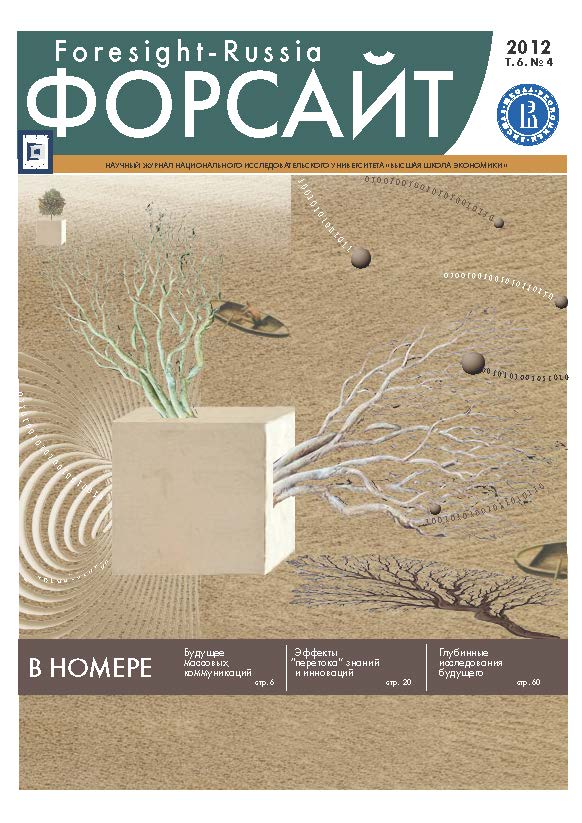Abstract
Stanislav Zaichenko — Senior Research Fellow, Laboratory for Economics of Innovation, Institute for Statistical Studies and Economics of Knowledge, National Research University — Higher School of Economics. E-mail: szaichenko@hse.ru. Address: National Research University — Higher School of Economics, 20, Myasnitskaya str., Moscow, 101000
Science, technology and innovation policy in Russiais at thethreshold of the transitionto a complexsystem of flexibletargetedregulation andthe development of innovation activities.In parallel, increasing attention is paid to the definition of guidelines and typologies to distinguish behaviors of key actors in the innovation processes, their development strategies, and features of individual performance. The paper analyzes the basic strategies that guide domestic organizations engaged in research and development when transferring the results of their activities to industry. The study is based on micro data collected by the HSE ISSEK experts in 2011 in the framework of the project “Innovation Activities of the Innovation Process Actors Monitoring” and it uses factor analysis.
Depending on the degree of novelty of the transferred technologies there are three identified segments of scientific organizations manifesting one of the following behavioral patterns: innovation (introduction of developments that are unique both in domestic and foreign markets, and feature qualitatively new characteristics matching or surpassing current standards), modification (introduction of technologies new to the implementing organization, although not to the market and adaptation (modification and improvement of technology previously used by the implementing organization).
Analyzing the key features of research organizations allows composing an average depiction of separate segments. The study reveals significant differences between these segments in their methods and means of technology transfer and required public support mechanisms. The conclusion presents policy recommendations.
References
Arrow K.J. (1962) Economic Welfare and the Allocation of Resources for Inventions//Nelson R.R. (ed.) The Rate and Direction of Inventive Activity: Economic and Social Factors. Princeton: Princeton University Press. P. 609-625.
Bekkers R., Freitas I.M.B. (2008) Analysing knowledge transfer channels between universities and industry: To what degree do sectors also matter?//Research Policy. Vol. 37. P. 1837-1853.
Chesbrough H. (2003) Open Innovation: The New Imperative for Creating and Profiting from Technology. Boston, MA: Harvard Business School Publishing.
Cohen W.M., Nelson R.R., Walsh J.P. (2002) Links and impacts: The influence of public research on industrial R&D//Management Science. Vol. 48. № 1. P. 1-23.
ETEPS (2011) Analysis of the evolution of the costs of research -Trends, drivers and impacts. Final report. Study commissioned by DG Research & Innovation Contract: RTD/B2/2009/COST-2009-01. Brussels.
Encaoua D., Guellec D., Martínez C. (2006) Patent systems for encouraging innovation: Lessons from economic analysis//Research Policy. Vol. 35. № 9. P. 1423-1440.
Etzkowitz H. (1994) Academic-industry relations: A sociological paradigm for economic development//Leydesdorff L., Van den Besselaar P. (eds.) Evolutionary Economics and Chaos Theory: New Directions in Technology Studies. London: Pinter. P. 139-151.
Evangelista R. (2000) Sectoral Patterns of Technological Change in Services//Economics of Innovation and New Technology. Vol. 3. № 9. P. 183-222.
Freeman C. (1995) The National System of Innovation in Historical Perspective//Cambridge Journal of Economics. № 19. P. 5-24.
Freeman C., Soete L. (1997) The Economics of Industrial Innovation (3rd ed.). London, Washington: Continuum.
Lundvall B-Å. (ed.) (1992) National Innovation Systems: Towards a Theory of Innovation and Interactive Learning. London: Pinter.
Mansfield E. (1985) How Rapidly Does New Industrial Technology Leak Out?//The Journal of Industrial Economics. Vol. 34. № 2. P. 217-223.
Marsili O. (2001) The Anatomy and Evolution of Industries: Technological Change and Industrial Dynamics. Cheltenham, UK and Northampton, MA: Edward Elgar.
Meyer-Krahmer F., Schmoch U. (1998) Science-based technologies: University-industry interactions in four fields//Research Policy. Vol. 27. P. 835-851.
Monjon S.,Waelbroeck P. (2003) Assessing spillovers from universities to firms: Evidence from French firm-level data//International Journal of Industrial Organization. Vol. 21. P. 1255-1270.
Nelson R. (1959) The Simple Economics of Basic Scientific Research//Journal of Political Economy. Vol. 67. P. 297-306.
OECD (2002) Frascati Manual 2002: Proposed Standard Practice for Surveys on Research and Experimental Development. Paris: OECD.
OECD (2011a) Public Research Institutions: Mapping Sector Trends. Paris: OECD.
OECD (2011b) Scoping Paper for the TIP Project on “Financing, Transferring and Commercialising Knowledge”. DSTI/STP/TIP(2011)3. Paris: OECD.
Orr D., Jaeger M., Wespel J. (2011) New forms of incentive funding for public research: A concept paper on research excellence initiatives. DSTI/STP/RIHR(2011)9. Paris: OECD.
Oxford University (1993) National Innovation Systems. A Comparative Analysis/ed. R. Nelson. New York, Oxford: Oxford University Press.
Pavitt K. (1984) Sectoral patterns of technical change: Towards a taxonomy and a theory//Research Policy. Vol. 13. P. 343-373.
Podsakoff P.M., MacKenzie S.B., Lee J.-Y. (2003) Common Method Bias in Behavioral Research: A Critical Review of the Literature and Recommended Remedies//The Journal of Applied Psychology. Vol. 88. № 5. P. 879-903.
Schartinger D., Rammer C., Fischer M.M., Fröhlich J. (2002) Knowledge interactions between universities and industry in Austria: Sectoral patterns and determinants//Research Policy. Vol. 31. P. 303-328.
Schumpeter J. (1934) The Theory of Economic Development. Cambridge: Harvard University Press.
Svensson R. (2007) Commercialization of patents and external financing during the R&D phase//Research Policy. Vol. 36. № 7. P. 1052-1069.
von Hippel E. (2005) Democratizing innovation. Cambridge, MA: MIT Press.
Гохберг Л.М., Кузнецова Т.Е., Рудь В.А. (2010) Анализ инновационных режимов в российской экономике: методологические подходы и первые результаты//Форсайт. Т. 4. № 3. С. 18-30.
Заиченко С.А. (2007) Развитие инноваций в сфере услуг//Форсайт. Т. 1. № 1. С. 30-33.
Заиченко С.А. (2008) Центры превосходства в системе современной научной политики//Форсайт. Т. 2. № 1. С. 42-50.

This work is licensed under a Creative Commons Attribution 4.0 International License.

